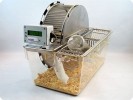Authors
LA Gri_ths, NA Duggett, AL Pitcher, SJL Flatter
Lab
Wolfson Centre for Age-Related Diseases, King’s College London, London, UK
Journal
Pain Research and Management
Abstract
Paclitaxel-inducedneuropathicpainisamajordose-limitingsidee_ectofpaclitaxeltherapy.Thisstudycharacterisesavarietyof rat behavioural responses induced by intermittent administration of clinically formulated paclitaxel. 2mg/kg paclitaxel or equivalentvehiclewasadministeredintraperitoneallyondays0,2,4,and6toadultmaleSprague-Dawleyrats.Evokedpain-like behaviours were assessed with von Frey _laments, acetone, or radiant heat application to plantar hind paws to ascertain mechanical, cold, or heat sensitivity, respectively. Motor coordination was evaluated using an accelerating RotaRod apparatus. Ongoing pain-like behaviour was assessed via spontaneous burrowing and nocturnal wheel running. Mechanical and cold hypersensitivity developed after a delayed onset, peaked approximately on day 28, and persisted for several months. Heat sensitivity and motor coordination were unaltered in paclitaxel-treated rats. Spontaneous burrowing behaviour and nocturnal wheelrunningweresigni_cantlyimpairedonday28,butnotonday7,indicatingongoingpain-likebehaviour,ratherthanacute drug toxicity. This study comprehensively characterises a rat model of paclitaxel-induced peripheral neuropathy, providing the _rstevidenceforongoingpain-likebehaviour,whichoccursinparallelwithmaximalmechanical/coldhypersensitivity.Wehope that this new data improve the face validity of rat models to better re_ect patient-reported pain symptoms, aiding translation of new treatments to the clinic.
BIOSEB Instruments Used:
Spontaneous activity wheels (BIO-ACTIVW-M)

 Pain - Thermal Allodynia / Hyperalgesia
Pain - Thermal Allodynia / Hyperalgesia Pain - Spontaneous Pain - Postural Deficit
Pain - Spontaneous Pain - Postural Deficit Pain - Mechanical Allodynia / Hyperalgesia
Pain - Mechanical Allodynia / Hyperalgesia Learning/Memory - Attention - Addiction
Learning/Memory - Attention - Addiction Physiology & Respiratory Research
Physiology & Respiratory Research
 Pain
Pain Central Nervous System (CNS)
Central Nervous System (CNS) Neurodegeneration
Neurodegeneration Sensory system
Sensory system Motor control
Motor control Mood Disorders
Mood Disorders Other disorders
Other disorders Muscular system
Muscular system Joints
Joints Metabolism
Metabolism Cross-disciplinary subjects
Cross-disciplinary subjects Happy new year 2025
Happy new year 2025 